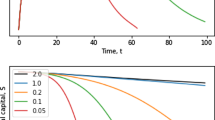Abstract
I argue that there is no fundamental conflict between economic growth and biodiversity. Humans can maintain and produce biological diversity just as we can maintain and produce other goods. Efforts to preserve and enhance biodiversity add to the size and growth of the economy. We are losing biodiversity because of human preferences and human inefficiencies, not because of economic growth. Inefficiency occurs when our actions do not reflect our real preferences, and is mainly due to failures of social coordination. To alleviate the problem of biodiversity loss we should address these failures.
Similar content being viewed by others
References
Asafu-Adjaye J (2003) Biodiversity loss and economic growth: a cross-country analysis. Contemp Econ Policy 21:173–185
Balmford A, Bruner A, Cooper P, Costanza R, Farber S, Green RE, Jenkins M, Jefferiss P, Jessamy V, Madden J, Munro K, Myers N, Naeem S, Paavola J, Rayment M, Rosendo S, Roughgarden J, Trumper K, Turner RK (2002) Economic reasons for conserving wild nature. Science 297:950–953
Caplan B (2007) The myth of the rational voter why democracies choose bad policies. Princeton University Press, Princeton
Czech B (2008) Prospects for reconciling the conflict between economic growth and biodiversity conservation with technological progress. Conserv Biol 22:1389–1398
Darwin C (1868) The variation of animals and plants under domestication. Murray, London
Davis MA (2003) Biotic globalization: does competition from introduced species threaten biodiversity? Bioscience 53:481–489
Diaz S, Fargione J, Chapin FS, Tilman D (2006) Biodiversity loss threatens human well-being. PLoS Biol 4:1300–1305
Dietz S, Adger WN (2003) Economic growth, biodiversity loss and conservation effort. J Environ Manag 68:23–35
Drake A, Klingenberg C (2010) Large-scale diversification of skull shape in domestic dogs: disparity and modularity. Am Nat 175:289–301
Ellis EC, Ramankutty N (2008) Putting people in the map: anthropogenic biomes of the world. Front Ecol Environ 6:439–447
Ernst & Young (2006) Beyond borders: a global perspective. The global biotechnology report 2006. Ernst & Young, London
Ernst & Young (2009) Beyond borders: global biotechnology report 2009. Ernst & Young, London
Gutman P, Davidson S (2007) A review of innovative international financial mechanisms for biodiversity conservation—with a special focus on the international financing of developing countries’ protected areas. WWF-MPO, Washington, DC
Hacker SD, Gaines SD (1997) Some implications of direct positive interactions for community species diversity. Ecology 78:1990–2003
Helms JA, Brugmann SA (2007) The origins of species-specific facial morphology: the proof is in the pigeon. Integr Comp Biol 47:338–342
Hillmann BM, Barkmann J (2009) Conservation: a small price for long-term economic well-being. Nature 461:37–38
Hobbs RJ, Arico S, Aronson J, Baron JS, Bridgewater P, Cramer VA, Epstein PR, Ewel JJ, Klink CA, Lugo AE, Norton D, Ojima D, Richardson DM, Sanderson EW, Valladares F, Vilà M, Zamora R, Zobel M (2006) Novel ecosystems: theoretical and management aspects of the new ecological world order. Glob Ecol Biogeogr 15:1–7
Hooper DU, Bignell DE, Brown VK, Brussaard L, Dangerfield JM, Wall DH, Wardle DA, Coleman DC, Giller KE, Lavelle P, van der Putten WH, de Ruiter PC, Rusek J, Silver WL, Tiedje JM, Wolters V (2000) Interactions between aboveground and belowground biodiversity in terrestrial ecosystems: patterns, mechanisms, and feedbacks. Bioscience 50:1049–1061
Horton B, Colarullo G, Bateman IJ, Peres CA (2003) Evaluating non-user willingness to pay for a large-scale conservation programme in Amazonia: a UK/Italian contingent valuation study. Environ Conserv 30:139
James A, Gaston KJ, Balmford A (2001) Can we afford to conserve biodiversity? Bioscience 51:43–52
Jones CG, Lawton JH, Shachak M (1994) Organisms as ecosystem engineers. Oikos 69:373–386
Kylafis G, Loreau M (2011) Niche construction in the light of niche theory. Ecol Lett 14:82–90
Marquis RJ (2005) Impacts of herbivores on tropical plant diversity. In: Burslem DFRP, Pinard MA, Hartley SE (eds) Biotic interactions in the tropics: their role in the maintenance of species. Cambridge University Press, Cambridge, pp 328–346
Mills JH, Waite TA (2009) Economic prosperity, biodiversity conservation, and the environmental Kuznets curve. Ecol Econ 68:2087–2095
Naidoo R, Adamowicz WL (2001) Effects of economic prosperity on numbers of threatened species. Conserv Biol 15:1021–1029
Paine RT (1966) Food web complexity and species diversity. Am Nat 100:65–75
Palmer M, Bernhardt E, Chornesky E, Collins S, Dobson A, Duke C, Gold B, Jacobson R, Kingsland S, Kranz R, Mappin M, Martinez ML, Micheli F, Morse J, Pace M, Pascual M, Palumbi S, Reichman OJ, Simons A, Townsend A, Turner M (2004) Ecology for a crowded planet. Science 304:1251–1252
Pearce D (2005) Paradoxes in biodiversity conservation. World Econ 6:57–69
Pearce D (2007) Do we really care about biodiversity? Environ Resour Econ 37:313–333
Pearce D, Moran D (1994) The economic value of biodiversity. IUCN—The World Conservation Union, London
Rosenzweig ML (2003) Win-win ecology. Oxford University Press, Oxford
Sax DF, Gaines SD (2003) Species diversity: from global decreases to local increases. Trends Ecol Evol 18:561–566
Skourtos M, Kontogianni A, Harrison PA (2010) Reviewing the dynamics of economic values and preferences for ecosystem goods and services. Biodivers Conserv 19:2855–2872
Stachowicz JJ (2001) Mutualism, facilitation, and the structure of ecological communities. Bioscience 51:235–246
TEEB (2009) The economics of ecosystems and biodiversity for national and international policy makers. TEEB, Bonn. http://www.teebweb.org. Accessed November 2010
Author information
Authors and Affiliations
Corresponding author
Rights and permissions
About this article
Cite this article
Fuentes, M. Economic growth and biodiversity. Biodivers Conserv 20, 3453–3458 (2011). https://doi.org/10.1007/s10531-011-0132-y
Received:
Accepted:
Published:
Issue Date:
DOI: https://doi.org/10.1007/s10531-011-0132-y




